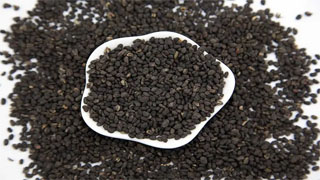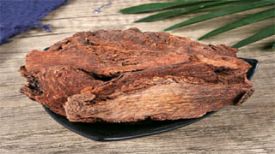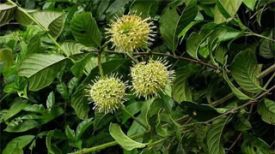
1. Alias
Broken paper, Hu Jiuzi, Po Gu Zhi, Bu Gu Yao, Hei Gu Zi.
2. Plant morphology
Annual herb, covered entirely with yellow white hairs and black brown glandular spots. The stem is upright, the branches are hard, and have longitudinal edges. Leaves alternate, with one small leaf often growing laterally at the end of the branch; The leaves are broadly ovate or triangular ovate in shape, with a rounded or blunt tip and a heart-shaped, oblique heart-shaped, or circular base. The edges have coarse broad teeth, and there are significant black glandular spots on both sides of the leaves; The petiole is covered with white hairs; Leaves paired, triangular lanceolate, membranous. Multiple flowers, densely clustered into spike shaped racemes; Flower axis axillary; Calyx bell shaped, with a tubular base and 5 teeth at the tip, covered by black glandular dots; Crown butterfly shaped, light purple or yellow; 10 stamens, 1 bundle, small anthers; Pistil 1, ovary superior, inverted or linear, style filamentous. The pod is elliptical in shape, with persistent sepals, black skin, and 1 seed. It has a fragrant and fishy aroma. The flowering period is from July to August, and the fruiting period is from September to October.
3. Origin distribution
Born on hillsides, streams, or fields. Mainly produced in Henan, Sichuan, Anhui and other places.
4. Harvesting and processing
Harvest fruits in autumn when they are ripe, remove impurities, and dry them in the sun.
5. Characteristics of medicinal herbs
Flat round kidney shaped, slightly pointed at one end, with occasional persistent sepals. Length is 4-5.5 millimeters, width is 2-4 millimeters, and thickness is about 1 millimeter. The surface is black brown or brownish brown, with fine mesh patterns, and numerous point like concave convex textures can be seen under a magnifying glass. The texture is relatively hard and brittle. After cutting open, it can be seen that the fruit skin is closely attached to the outer seed coat, with a thickness of less than 0.5 millimeters. After removing the fruit skin, a small dot like navel can be seen, located slightly below the upper end of the concave side of the seed, with the commissure at the other end, and the seed ridge is not obvious. The outer cortex is relatively hard, gray white, without endosperm, with two cotyledons, thick, light yellow to light yellow brown, and white substances are often visible on its inner and outer surfaces; The embryo is very small and visible. The basal part of the calyx is united, with 5 lobes at the upper end, gray yellow, hairy, and densely covered with brown glandular spots. The aroma is unique, with a bitter and slightly pungent taste.
6. Sexual Taste Returning to the Classics
Warm in nature, spicy and bitter in taste. Return to the Kidney Meridian and Spleen Meridian.
7. Effect and Function
Warm the kidneys, promote yang, absorb qi, and stop diarrhea. Belonging to the subcategory of tonifying deficiency medicine, it is a type of tonifying yang medicine.
8. Clinical application
Dosage: 3-10g, suitable for external use. Used to treat symptoms such as kidney yang deficiency, cold pain in the waist and knees due to weakened vital energy, erectile dysfunction, nocturnal emissions, frequent urination, spleen and kidney yang deficiency diarrhea, kidney deficiency asthma due to lack of qi absorption, and vitiligo.
9. Pharmacological research
This product can dilate coronary arteries, excite the heart, and increase heart power; Can contract the uterus, shorten bleeding time, and reduce bleeding volume; Anti early pregnancy and estrogen like effects; It has a photosensitive effect, and when taken orally or applied externally to the skin, it can cause local skin pigmentation when exposed to sunlight or ultraviolet radiation. In addition, it also has anti-tumor, anti-aging, antibacterial, insecticidal, and estrogen like effects.
10. Chemical composition
Containing aromatic bean essence, mainly including psoralen and isopsoralen (Angelica dahurica), as well as various components such as chalcones, flavonoids, monoterpenes, Sichuan pepper toxins, isopsoralen dihydroflavones, psoralen dihydroflavones, isopsoralen chalcones, psoralen B, stigmasterol, bone fat phenols, and sub oils.
11. Usage taboos
Those with yin deficiency and excessive fire should avoid taking it.
12. Compatibility prescription
① For the treatment of pregnancy induced back pain, if the symptoms are unbearable, do not use too much psoralen, stir fry on tiles until fragrant and cooked, then use as powder. Chew half of the walnut flesh, hollow, and mix 6 grams with warm wine. (The Good Women's Formula "Ventilation Powder)
② Common methods for treating falls, congealing blood stasis, and lower back pain include stir fried Fructus Psorale (fragrant and researched), stir fried fennel, and spicy cinnamon. Above is the end. Take 6 grams per serving, adjust to hot wine, and eat before consumption. (Zhizhi Fang Fennel Wine)
③ Treating women's blood collapse: equal parts of Fructus Psorale (stir fried), Pu Huang (stir fried), Thousand Year Lime, and Rhubarb are finely ground. Take 9 grams per serving, hollow, and mix with hot wine. Standing still. (Revised Experience Formula for Ruizhu Hall, Pu Huang San)
④ Treating red and white discharge: Divide the parts of Fructus Psorale and Acorus calamus into equal parts (file and stir fry). Above is the end. Take 6 grams per serving, soak in Acorus calamus wine, and warm. (The Good Women's Formula is Broken Away)
⑤ Treating toothache for a long time and kidney deficiency: 60 grams of psoralen and 15 grams of green salt. Stir fry, grind, and rub. (Imperial Pharmacy Prescription)
⊙ The content of the article is for clinical reference only. Non TCM professionals are not allowed to test drugs.


